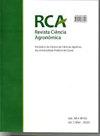Gas exchange in forage cactus cultivars of genera Opuntia and Nopalea (Cactaceae)
IF 0.7
4区 农林科学
Q3 AGRICULTURE, MULTIDISCIPLINARY
引用次数: 0
Abstract
- Forage cactus species are cultivated in northeaster Brazil for feed, mainly during dry periods, as cacti are xerophytes well adapted to drought. Gas exchange studies have elucidated the physiological mechanisms underlying plant adaptation to ecosystems with low water availability. Here, we evaluated the variability between and within cactus forage genera Opuntia and Nopalea with respect to gas exchange behaviour. Twenty-one cultivars were used, 16 of which belonged to genus Opuntia , while six belonged to genus Nopalea , particularly, O. cochenillifera . Gas exchange was evaluated in the secondary cladode at 00:00 hours using a portable infrared gas analyser. Net CO 2 assimilation rate, stomatal conductance, CO 2 intercellular concentration, transpiration rate, and leaf temperature were evaluated. Additionally, instantaneous water use efficiency, intrinsic water use efficiency, and instantaneous carboxylation efficiency were calculated. Boxplots were used to assess value dispersion between the genera prior to submitting the data to multivariate analysis of principal components and cultivar-based grouping, and subsequently organizing the species studied in a dendrogram. Variability between the two genera and among cactus forage cultivars was detected for gas exchange. Cultivars were classified into three groups and two main components were identified. Cultivars ‘Verdura’ and ‘Orelha de Elefante Mexicana’ showed higher photosynthetic performance.仙人掌科仙人掌属和仙人掌属牧草品种气体交换的研究
本文章由计算机程序翻译,如有差异,请以英文原文为准。
求助全文
约1分钟内获得全文
求助全文
来源期刊

Revista Ciencia Agronomica
Agricultural and Biological Sciences-Horticulture
CiteScore
2.00
自引率
0.00%
发文量
41
审稿时长
4-8 weeks
期刊介绍:
To publish technical-scientific articles and study cases (original projects) that are not submitted to other journals, involving new researches and technologies in fields related to Agrarian Sciences. Articles concerning routine analysis, preliminary studies, technical notes and those which merely report laboratorial analysis employing traditional methodology will not be accepted for publication. The Journal of Agronomical Science also has the mission to promote the exchange of experience in the referred fields.
 求助内容:
求助内容: 应助结果提醒方式:
应助结果提醒方式:


